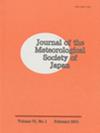Refinement of the Use of Inhomogeneous Background Error Covariance Estimated from Historical Forecast Error Samples and its Impact on Short-Term Regional Numerical Weather Prediction
IF 1.6
4区 地球科学
Q3 METEOROLOGY & ATMOSPHERIC SCIENCES
引用次数: 3
Abstract
Background error covariance (BEC) is one of the key components in data assimilation systems for numerical weather prediction. Recently, a scheme of using an inhomogeneous and anisotropic BEC estimated from historical forecast error samples has been tested by utilizing the extended alpha control variable approach (BEC-CVA) in the framework of the variational Data Assimilation system for the Weather Research and Forecasting model (WRFDA). In this paper, the BEC-CVA approach is further examined by conducting single observation assimilation experiments and continuous-cycling data assimilation and forecasting experiments covering a 3-week period. Additional benefits of using a blending approach (BEC-BLD), which combines a static, homogeneous BEC and an inhomogeneous and anisotropic BEC, are also assessed. Single observation experiments indicate that the noise in the increments in BEC-CVA can be somehow reduced by using BEC-BLD, while the inhomogeneous and multivariable correlations from BEC-CVA are still taken into account. The impact of BEC-CVA and BEC-BLD on short-term weather forecasts is compared with the threedimensional variational data assimilation scheme (3DVar) and also compared with the hybrid ensemble transform Kalman filter and 3DVar (ETKF-3DVar) in WRFDA. The results show that BEC-CVA and BEC-BLD outperform the use of 3DVar. BEC-CVA and BEC-BLD underperform ETKF-3DVar, as expected. However, the computational cost of BEC-CVA and BEC-BLD is considerably less expensive because no ensemble forecasts are required. Journal of the Meteorological Society of Japan Vol. 96, No. 5 430历史预报误差样本估计非均匀背景误差协方差的改进及其对短期区域数值天气预报的影响
背景误差协方差(BEC)是数值天气预报同化系统的关键组成部分之一。最近,在天气研究与预报模型(WRFDA)变分数据同化系统的框架下,利用扩展α控制变量方法(BEC- cva),对一种利用历史预报误差样本估计的非均匀各向异性BEC进行了测试。本文通过单次观测同化实验和3周连续循环数据同化预报实验,进一步验证了bc - cva方法。使用混合方法(BEC- bld)的其他好处,它结合了静态、均匀BEC和非均匀、各向异性BEC,也进行了评估。单次观测实验表明,该方法可以在一定程度上降低bc - cva增量中的噪声,同时仍然考虑到bc - cva的非均匀性和多变量相关性。将bc - cva和bc - bld对短期天气预报的影响与WRFDA的三维变分同化方案(3DVar)以及混合集合变换卡尔曼滤波和3DVar (ETKF-3DVar)进行了比较。结果表明,becc - cva和becc - bld的使用效果优于3DVar。正如预期的那样,BEC-CVA和BEC-BLD表现不及ETKF-3DVar。然而,由于不需要集合预报,因此bc - cva和bc - bld的计算成本要低得多。日本气象学会学报,第96卷,第5430期
本文章由计算机程序翻译,如有差异,请以英文原文为准。
求助全文
约1分钟内获得全文
求助全文
来源期刊
CiteScore
6.70
自引率
16.10%
发文量
56
审稿时长
3 months
期刊介绍:
JMSJ publishes Articles and Notes and Correspondence that report novel scientific discoveries or technical developments that advance understanding in meteorology and related sciences. The journal’s broad scope includes meteorological observations, modeling, data assimilation, analyses, global and regional climate research, satellite remote sensing, chemistry and transport, and dynamic meteorology including geophysical fluid dynamics. In particular, JMSJ welcomes papers related to Asian monsoons, climate and mesoscale models, and numerical weather forecasts. Insightful and well-structured original Review Articles that describe the advances and challenges in meteorology and related sciences are also welcome.

 求助内容:
求助内容: 应助结果提醒方式:
应助结果提醒方式:


